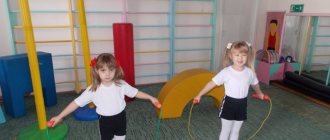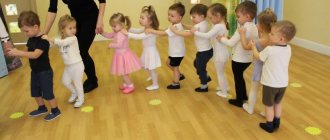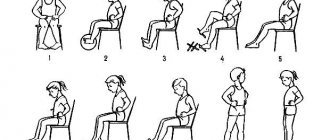Morning exercises are the key to vivacity and good mood for the whole day. Simple, understandable exercises fill the whole body with energy and disperse the remnants of sleep.
The increased activity of preschool children is directly related to important stages of body development - the growth and development of internal organs. Every cell in the body requires sufficient oxygen. To deliver this important element for development to all systems of the child, movement is constantly required.
The role of parents in shaping the health of the toddler is to create the necessary conditions for good nutrition, physical activity, and the acquisition of skills. One type of physical activity that promotes proper formation is exercise.
- What does charging consist of?
Why do you need charging?
A set of exercises called exercises is carried out with children from birth and is recommended for use throughout the entire period of growing up. Aimed at maintaining a high level of activity, physical development and stimulation of metabolic processes, it is carried out once or twice a day after sleep.
Regular use of exercises has many positive aspects. In particular, the morning warm-up complex:
- Strengthens the muscular system. With the help of specially selected exercises, it is easy to train the required muscle group;
- Increases vitality. Nothing invigorates you in the morning like a fun motor game;
- Improves appetite;
- Activates the work of all organs, especially the respiratory and cardiovascular systems;
- Allows you to form and maintain correct posture;
- Develops coordination;
- Develops endurance and discipline;
- Increases durability;
- Uplifting;
- It calms excitable children, and activates slow ones.
Simple, understandable, enjoyable exercises for the child allow you to start the day in a good mood, prepare for an active pastime, and develop the correct daily routine.
Features of the morning warm-up complex for preschool children
To get the maximum benefit from morning exercises, you must follow some recommendations based on many years of experience as educators, pediatricians and physiologists. The rules are very simple, but require regular implementation.
Time spending
The duration of morning exercises depends on the age of the child. For a newborn and baby, exercise consists of massage and exercises and lasts about 15 minutes.
Children over one year old who can walk can perform the gymnastics routine independently.
- For children 1-2 years old, the duration of one lesson should be about 5 minutes,
- for 3-4 years – 5-8 minutes,
- 5-6 years – 8-10 minutes,
- 7-10 years – 10-15 minutes.
Cloth
You should carefully consider the choice of clothes and shoes for classes. We recommend comfortable wardrobe items made of cotton fabric that do not restrict movement. It is not allowed to have large seams, buttons or other objects that can rub or create discomfort during active movement or performing exercises while lying on your back or stomach.
At home, you don’t have to wear shoes when charging, but it is advisable to wear socks on your feet.
Conditions
A home set of exercises must be carried out in a thoroughly ventilated area. For additional hardening of the body, it is good if the air is a little cool (about 18 degrees).
It is advisable to offer exercises before meals or 40 minutes after meals.
Carefully inspect the exercise area. Remove all unnecessary items and secure corners or moving parts. It is most convenient if there is enough space in the room where the charging is carried out for a short jog.
Form of conduct
Preschool children enjoy completing tasks using game elements. It’s good if morning exercises have a plot (visiting a bear or bunny; imitation of animals and plants). It is worth paying close attention to the name of the exercises presented to the toddler. Figurative, rich speech explaining the necessary actions will help the child remain interested in such pastime for a long time.
Additional items
If you decide to use additional equipment in the complex (ball, fitball, jump rope), then prepare the selected items in advance. There is no need to interrupt classes for a long search for the necessary equipment.
Pace and order
To benefit from morning exercises you need to:
- Regulate the speed of the exercises, suggesting that you perform them slowly at first, then speed up, reach the fastest version of the exercise, then slowly reduce the speed and stop. Preschool children are not recommended to stop abruptly when performing fast exercises;
- The lesson plan should be built as the tasks become more complex. The first thing you need to do is warm up. After warming up, offer to perform the exercises of the main complex. You should complete the exercise with a calm step in place and self-massage;
- Try to focus not on the number of elements completed, but on the quality of execution. If you asked your baby to walk with his knees high, then it is better to take 5 correct high steps than 25 fast and not high ones.
Baby's mood
Exercise is an activity that brings pleasure and joy. It should be feasible and pleasant for the little one. You should not force or overstrain your little athlete. If he doesn't feel well or gets up in a bad mood, it may be better to postpone the exercises and do them later. It’s good to captivate the baby by your own example.
Purpose of the lesson
Morning exercises allow anyone not only to wake up from sleep, but also to tune in for the whole next day.
Monotonous exercises give you the opportunity to think and plan your day. If you start exercising at a certain time, it, as a daily obligatory activity, is an excellent discipline. For an adult, morning exercise can consist not only of exercise, but also of walking the dog in the morning, getting the children ready for kindergarten, school, preparing breakfast, and getting ready for work. Children are unlikely to go to kindergarten on their own. Parents have difficulty getting them up, helping them get dressed, comb their hair, and making them eat breakfast. Morning exercises await them in the kindergarten. This particular exercise is not just a physical exercise procedure, but the baby’s first mandatory independent work. Although children repeat the exercises after the teacher, they still learn to do work in a disciplined manner at a certain time, and then in a team. In the long term, this is the main goal of morning exercises, and not the physical development of children, who already move so much that they need to be stopped, and not forced to do anything.
The teacher’s task is not a formal approach in accordance with the requirements of the Federal State Educational Standard, but to develop, based on state standards, his own complex, convenient for the teacher. When developing, it is necessary to take into account the usefulness for children from different sides - it is important to develop not only physical qualities, dexterity, but also listening skills, musical qualities, possibly speech skills, as well as the ability to accurately perform tasks at the request of the teacher.
An ideal exercise should last no more than 15 - 20 minutes and include a warm-up, exercises, a game part, and possibly a small quiz. The task of creating a good complex is not an easy one, but, as in any pedagogical work, after working hard for the first year, getting the kids interested in fun play exercises of the author’s work, you can enjoy the fruits of your achievements for many years.
How to involve your child in doing exercises
The main condition for receiving benefits from the morning gymnastics complex is the baby’s interest in the process. Preschool age is a time of games, learning through action, rapid changes of interest. To attract your toddler to perform the proposed exercises, you need to meet several conditions:
- Cheerfulness. The baby should be in a good mood and healthy;
- Game elements. It’s good if morning exercises start with a story that requires action from the child (we’ll go to a forest clearing to see a squirrel), the names of the exercises will be funny and interesting (butterfly wings - swinging your arms, a bunny in a clearing - jumping), any bend or squat will correspond to a certain image (tilt - we collect flowers, step - we go to visit). An excellent option is poetic exercises, but adults need to know the corresponding works by heart, recite them during the exercises, performing the suggested exercises together with the baby;
- Background music. Classic works or children's songs that set the mood for a cheerful, cheerful wave will create a festive atmosphere, stimulating motor activity. Music should not be played too loudly;
- Parental example. Do you want to attract the “unwilling” to exercise? Start doing it yourself. Seeing the pleasure derived from exercise, the baby will certainly want to join in. The attitude of adults towards exercise plays an important role in forming a correct understanding of the necessary tasks for the morning. It is impossible to force and teach a child to do exercises if he does not see an example from the people closest to him;
- Praise and encouragement. Each correctly performed exercise should be praised and noted. Your approval will contribute to the desire to perform movements correctly and do gymnastics daily.
An interested child will gradually understand his body better and strive to perform more exercises. But don't be overzealous. Stop your overly persistent baby and don’t let him get too tired. The purpose of morning exercises is to awaken the body through movement, maintaining correct posture, and light physical activity. Excessive implementation of the morning complex can reduce the activity of the baby during the day.
Day after day, you will observe how your baby’s coordination improves and his visual-motor skills develop. If at first (age 1-2 years) it is not necessary to regulate and plan a morning gymnastics complex, then with the development of basic exercises it is worthwhile to work out the issue of necessary loads and the introduction of new exercises.
What is charging for?
Morning exercises perform the following functions:
- Self-organization. A child accustomed to morning exercises is self-organized. It is easier for him to maintain a daily routine.
- Boosting immunity. If your child has difficulty getting up in the morning, does poorly in school and is constantly sick, try teaching him to do morning exercises. It’s even better if it is combined with hardening. This will give him a sense of routine.
- Incentive for a healthy lifestyle. A child accustomed to exercise from childhood gives preference to sports rather than bad habits.
- Good mood. Just 30 minutes of exercise can help you feel positive throughout the day.
- Physical development. Children who have the habit of regularly exercising with their parents develop well and receive positive grades in physical education.
How to create a lesson plan
A clear understanding of the exercises necessary to perform allows parents to promptly help their child develop the necessary muscle groups and prepare them for mastering skills and abilities. Planning is especially important if the baby has some developmental disabilities and is prescribed to train a certain muscle group. Children with poor posture and scoliosis are often advised to focus on developing the spinal muscles when exercising.
There are several types of morning exercise planning:
- Long-term development plan;
- Daily plan;
- Scheme for introducing new exercises.
You can choose a specific type or use all three to get a complete picture of your baby’s motor skills development. It’s good if planning a morning gymnastics complex is combined with the overall development plan for the baby, complementing other types of training.
A long-term development plan can be prepared for a week, a month or six months. It can include the gradual development of a complex for the development of a certain area of the body, repetition of educational knowledge (with the help of a presented story). Usually the plan is worked out in a notebook or on another convenient storage medium and compiled into a single table that is hung on the wall. It is not necessary to describe in detail the progress of each lesson; it is enough to make notes about the necessary actions in a certain period of time.
Like any other planning, drawing up a scheme for a morning gymnastics complex should be flexible and be able to change. The next skill should be introduced after the previous one has been fully studied. The sequence of all exercises is built from simple to complex. When making a long-term plan, it is good to write down the periodic use of sports equipment or note the days when you will make changes.
The daily plan is drawn up on the basis of a general understanding of the necessary exercises, usually prepared the evening before the lesson. The course of charging, basic exercises, and necessary equipment are thought through. If necessary, various elements that attract the attention of the crumbs are developed or prepared (flowers that need to be collected; a jump rope or rope that needs to be crawled under).
If detailed planning is not for you, and you don’t want to miss out on any skill, then a scheme for introducing new exercises would be an ideal option. This is a table that is most often hung on the wall, containing a rough plan for teaching the baby new motor skills. A great option is to make a table with pictures depicting the action. With the help of such a poster, you can invite your child to repeat the image, while supporting him.
What does charging consist of?
What does charging consist of?
A morning gymnastics complex should always contain three main parts:
- Warm-up;
- Main complex;
- The final stage.
Warm-up
Before suggesting exercises to develop a specific muscle group, be sure to ask your baby to warm up. Let him walk, then run, wave his arms a little. Together with the baby, perform all the given movements.
During marching, it is most convenient to start telling the idea of the gymnastics complex, poems encouraging exercise, and start a story, during the development of which it will be necessary to perform various exercises.
The purpose of the warm-up is to warm up the muscles and joints to avoid unwanted consequences. Don't neglect this important part of charging.
Main complex
When the baby warms up well, you can begin the exercises of the chosen complex. It's good when you do every element together. Looking at your movements, the little one will try to repeat them. The example of an adult is a special motivation that makes it possible to create in the child a feeling of the importance and necessity of daily morning activities.
The basic exercises of the main part are aimed at developing the muscles of the whole body, improving joint mobility, and acquiring spatial orientation skills. Correct execution allows you to form and maintain posture, strengthen the body, and strengthen the immune system.
Final stage
At the end of the exercise, invite the baby to run and march. The ideal end to a morning gymnastics routine is a massage. Parents do it for small children; after 1.5 years, it is good to teach the toddler self-massage techniques. Let the baby rub his arms, legs, stroke his shoulders and body. The morning gymnastics complex should end with a calm type of activity, to return breathing to normal, and gradually relax the muscles from vigorous activity.
To make preparing for morning exercises easier, we have prepared several exercise blocks for different muscle groups. It is advisable to introduce these exercises gradually, starting from 1.5-2 years, studying one from each block.
For convenience, the abbreviation I.P. is used. – starting position, which means that the child stands with his feet shoulder-width apart.
Examples of exercises for arms and shoulders
- I.P. Arms extended along the body. As you inhale, the arms rise up and the child stands on tiptoes. As you exhale, your arms lower down, your legs stand completely on your feet;
- I.P. Hands on the belt. As you exhale, your arms hug your body, and as you inhale, they return to your waist;
- I.P. Hands to the sides. As you exhale, bend over to your toes, trying to reach as far as possible;
- I.P. Hands along the body. As you exhale, squat, hands on knees. As he inhales, he rises, stands on his toes, stretches his arms up and returns to the standing position;
- I.P. As you inhale, wave your arms up, the body rises on your toes, and as you exhale, return to IP;
- I.P. Alternately, with both hands, while inhaling, a movement is made backwards and upwards. When the hand is raised at the top, exhale, a sharp movement imitates a throw and return to the I.P.;
- Feet wider than shoulders, arms down. As you exhale, bend forward, trying to touch the floor. As you inhale, rise up;
- The child walks around the room, trying to clap his hands, using the shoulder girdle as much as possible. Alternately makes a clap in front, above the head, behind the back;
- I.P. Bend forward, arms to the sides. Alternately, one hand reaches to the floor, the second rises up.
Examples of leg exercises
- I.P. Hands along the body. Slow squats with emphasis on the knees.
- Running with your legs raised as high as possible;
- A chair with a back at chest level is placed in front of the child. Holding onto a chair, he makes alternating swings of his legs in different directions, his knees do not bend;
- Several objects are displayed in a straight line. The child runs between objects, trying not to touch or miss;
- I.P. Hands on the belt. Walking on toes, heels, on the back and inside of the foot;
- I.P. Hands on the belt. Walking with high knees.
Exercises for the torso
- I.P. Hands clasped behind your back. As you inhale, bend forward and raise your arms. On exhalation, return to i. P.;
- I.P. Hands on the belt. Alternately turn the torso in different directions without lifting your legs off the floor. Make the exercise more difficult by adding a hand stretching in the direction of the turn;
- Lying on your back. Arms extended above head. As you inhale, roll onto your stomach. On exhalation - return back. Alternately perform over the left and right shoulders;
- Standing position. Heels together, toes apart. Hands crossed on shoulders. We jump on the spot. We complicate the exercises by asking you to jump around objects.
- Sitting on a chair. Feet are shoulder-width apart, hands hold knees. As you inhale, bend forward and turn your head to the left. As you exhale, return and repeat the exercise with turning your head to the right;
Stretching exercises
- The child gets on all fours, head down. When inhaling, the head rises, the body bends as much as possible. As you exhale, return to the starting position;
- Alternately place one leg forward and the other back. Slowly transferring your weight to the first leg, squat down as much as possible;
- Sitting on the floor, legs wide apart. Tilts towards the toes and forward;
- Standing, one hand tries to reach the shoulder blade, the second grabs the elbow and pulls back until a slight tension is felt. Repeat for the second hand;
- Lying on your back. We pull a scarf or ribbon over the foot. Pull your leg up.
Some important tips for parents
Morning exercises in kindergarten
Morning exercises are carried out in kindergarten either by a specialist physical instructor in the gym, or by the teacher himself directly in the group. As a rule, exercise begins half an hour before breakfast.
“Many parents, when they take their child into the locker room, immediately force them to put on Czech shoes. It is not right! If it’s still a long way from charging, let the baby change his shoes again later. Czech shoes are not shoes for running around in a group and playing! – warns physical instructor Savina E.V. (MBDOU No. 25, Moscow). “The child could be seriously injured.”
On weekends, it is advisable to conduct classes at home: both in the fresh air in the warm season, and in a room where ventilation has previously been done. You can use sports equipment (hoops, balls, skittles, etc.). It is good to do exercises both with a count and with the rhythmic sound of a tambourine.
- Charging begins with a warm-up - a short walk and light jogging in a circle.
- The next step could be an exercise to strengthen the neck muscles: circular movements of the head, head tilts and turns.
- After this, exercises are performed to strengthen the shoulder girdle and arms. For example, the “Grow Up” exercise:
- How to do it: feet shoulder-width apart, back straight. On the count of “one”, place your hands in front of you directly at chest level. “Two” - arms parallel up, “three” - to the sides, “four” - i.p. Repeat 3-7 times.
- Next, exercises are needed to strengthen the legs: squats, leg swings, alternate leg lifts at right angles, etc.
- The following exercises should be aimed at engaging the muscles of the torso, back and abdomen: bending forward, backward, sideways; body turns.
- The end can be calm walking with breathing restored.
Charging should have an average duration:
- for younger groups – 3-5 minutes;
- for medium groups – 5-7 minutes;
- for seniors and preparatory students – up to 12 minutes.
The set of exercises can be supplemented, but it is important that it equally includes both dynamic and static exercises.
Some important tips for parents
- No matter how much you would like to skip the warm-up or finish the exercise without the final step, you should not do this. Performing exercises can bring discomfort and lead to injury if the muscles and joints are not well warmed up;
- All exercises should be enjoyable for the baby; do not insist on continuing the activity if it is unpleasant or painful;
- Try to diversify your exercises as much as possible so that your baby doesn’t get tired of the activities;
- Use comparisons when explaining the exercise. It is good to use additional sports equipment;
- Do exercises 10-20 minutes after getting up, before breakfast;
- If possible, it is ideal to exercise outside in warm weather. In urban conditions, try to carry out the morning gymnastics complex in a well-ventilated room, without drafts;
- Watch your child carefully to perform the exercise correctly. If some element does not work out or is performed incorrectly, help the baby by holding it, or postpone the study until a later date;
- Up to 2 years of age, morning exercises contain only simple exercises to develop basic movements. Stretching exercises should not be introduced before this age;
- Exercises are selected from simple to complex, and they are performed in the same way;
- After completing the morning complex, it is good to carry out water procedures or rubdowns.
How to do exercises correctly
When organizing morning exercises for children, follow the recommendations:
- Ventilate the room well. Whenever possible, get outside to exercise in the fresh air.
- Do not exercise while sick. Or exclude heavy exercises that require increased stress on the body.
- The average charging time is 20 minutes.
- Turn on your favorite music, imitate dance moves - your baby will certainly like it.
- Exercise regularly. Only exclude sick days.
- Don't force your child to repeat your movements exactly. Even if he fails at the exercises, do not scold him or shame him.
- Always start with simple exercises.
- Give your child a drink of water before charging.
And the main thing is a good mood. Initially, let the exercises be a game, allow the child to come up with exercises himself. Gradually introduce more complex movements that require the use of physical strength.
Finished the exercises
Big achievements start with small victories. By instilling in the toddler the habit of doing exercises in the morning, parents solve several issues at once:
- Formation of a healthy body;
- Strengthening immunity;
- Accustoming to routine and discipline;
- Formation of the foundations of a healthy lifestyle;
- Eradicating the problem of lack of appetite.
These are only the obvious positive aspects of a simple and understandable action for everyone. By working with the child, motivating him and supporting the development of complex skills, adults create an atmosphere of love and well-being, allowing the baby to feel important and needed. Spending time together forms attachment and creates a feeling of security in the baby, maintains a trusting relationship, and lays the foundation for future sports victories.
If you liked the article, please share a link to it
Examples of exercises
Parents and educators need to remember that physical education in an educational institution is impossible without an adequate attitude to a healthy lifestyle at home. Parents should set an example for their children, not having bad habits, and also take care of their children - go with them to the sports ground, to the river, and on hikes.








